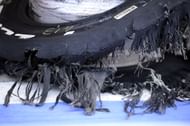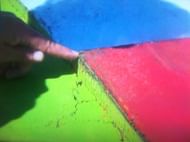What a race! It had everything, from safety cars and suffering race leaders, to an extremely scary event occurring not once, not twice, but an astonishing four times! How often does one see a tyre explode to pieces just like that; and for that to happen only to the rear left tyres of cars of four different teams? Spooky to say the least.
What makes it even more strange is that (with the exception of Sergio Perez, who suffered the same earlier in the weekend) the tyre blasts occurred only on race day. It was never an issue on Friday and Saturday. Clearly, something went wrong yesterday.
Let’s start with Lewis Hamilton. Leading the race from the start and being pushed to the limit by a chasing Sebastian Vettel, and it being his home race, Lewis was under severe pressure. But he was responding well enough. The Mercedes‘s lead did not evaporate within a space of a few laps as one may have expected. Hamilton was pushing hard, and more importantly, attacking the kerbs. More importantly, we are interested in one kerb here – at turn 4.
The kerb was damaged, evident from the above picture. Felipe Massa, who had made a brilliant start, also suffered the same fate as Hamilton. But is it sufficient to blame only the kerb? Each track has at least around 25 kerbs, and considering the number of tracks that we have been racing on, a singe kerb cannot be put to fault for ruining the race. If it were really an issue of track negligence, all kerbs should have been in the same state as the one on turn 4, which were not. So the kerb cannot be blamed entirely.
A theory was put forth in some quarters about the new bonding process used by Pirelli for this race. Here’s what Pirelli had to say about it:
“We can exclude that the new bonding process which we introduced at this race is the cause for the tyre failures we have seen.”
Clearly, Pirelli want to distance themselves from the mess, and such statements are not helping anybody at the moment. But could that be the only reason for the exploding tyres?
Now, they supply identical tyre sets to all the teams before the weekend begins. And for each track, the tyre construction, composition and durability is different. Not only that, each tyre piece’s characteristic is unique to the place where they are fit onto the car. That is, depending on the track layout, and how much load each tyre on the car takes during the course of a lap, or the extent of punishment of the tyres over a lap, each position’s tyre parameters are calculated.
Could Pirelli have got this estimation wrong for the left rears at Silverstone? Could these failures be a result of a simple miscalculation?
Another potential reason could be the GP2 race held earlier. The GP2 series mostly follows the F1 calendar and conducts its races a few hours before F1. Normally, the track is cleaned of all debris and readied for the F1 race. But this time, could the marshals be at fault?
A dirty track to begin with is never a safe sign – could this be why Lewis suffered a tyre failure so early? The GP2 event has been following the F1 events for years, so why should these failures be happening now?

Ferrari’s Felipe Massa’s shredded tyre is seen in the pits at the Silverstone circuit during the British Grand Prix
The only reason we can think of in blaming GP2 rubber for causing the F1 mayhem could not be the GP2 race itself, but the marshals cleaning up the race track during the preparation of the F1 race. I know they are the unsung heroes of motorsport, always at hand in all weather conditions and during any accident, but this time, they may be slightly at fault.
Weighing up these three reasons, I feel that Pirelli is more at fault than the others. Simply a really dirty track or a single kerb cannot explain four left rear tyres exploding without warning.
The problem calls for an immediate solution since the German Grand Prix at the Nurbergring is only a week away. A meeting has already been scheduled for Wednesday and one can only hope that a safe solution is found. One of the suggestions put forth so far include using last season’s tyres for this weekend’s race, or possibly beyond that till Pirelli get their act together.
But such a big change will be hamper the progress made by some teams like the Torro Rosso and Mercedes who are working better on this year’s tyres, while teams like Red Bull will be happy to use the tyres on which they clinched both championships last season. The tyre change mid-season could result in affecting the World Championship, and there will again be controversy.
If Pirelli pull out of the sport altogether, what are the options? Convincing Michelin, Bridgestone, or Goodyear to make a comeback? Or could another company enter the fray? Hard to see any of the above happening.
But what if teams approach tyre manufacturers on their own? Will FIA decide to allow teams to choose their own tyre manufacturers? That is, can FIA pull out from having a say in choosing tyre manufacturers? Then, it is up to the teams to choose their supplier.
This will make the situation more interesting. Some tyres may wear out faster but perform better, some may have a better life than others. Before the weekend commences, the FIA can verify if the tyres being used by each team are in accordance with the rules.
Now, in case of failure, the teams can fight it out with their manufacturer or simply approach another party. Then, people like Cristian Horner or Ross Brawn would have another aspect to think about – choosing their tyre supplier, in addition to the other successful choices they usually make.
Summary
Pirelli came into F1 in a tricky situation where refuelling had just been banned, and the FIA demanded them to make quicker wearing tyres. So far, they have done a decent job in playing to the FIA’s tunes. But in the aftermath of this British Grand Prix fiasco, they may have realized that they have taken a step too far.
Safety of drivers is of primary importance, and we can only hope that Pirelli, FIA, and the teams reach a decision this week and make the sport a lot safer than what we have just witnessed.

